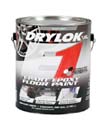DRYLOK®
E1 1-PART EPOXY FLOOR PAINT
A revolutionary 1-part epoxy floor paint that utilizes advanced epoxy
technology for excellent durability. E1 is resistant to hot tire marks
and pickup, chemicals, oil, grease and gasoline stains. Cleans up with
water and is storable. E1 is a semi-gloss coating.
DESCRIPTION
DRYLOK 1-Part Epoxy Floor Paint utilizes an Advanced Epoxy Technology
for greater protection and durability.
Specially formulated to protect and beautify interior and exterior concrete
floors, garage floors, basement floors, shop floors, carports, walkways,
driveways and patios. Not recommended for floor previously painted with
2 component epoxy paints.
SURFACE
PREP
The success of your project is dependent upon the degree of
surface preparation provided. Surface must be clean and free from dirt,
dust, grease, oil, soap, wax, concrete curing membranes and the oily
film left by sweeping compounds. Stains on the surface should be removed
using UGL DRYLOK Concrete Cleaner & Degreaser or a heavy duty detergent
until the surface is clean. Rinse thoroughly with clean water and allow
to dry completely. The concrete to be painted should have a slight texture,
such as a broom finish or the look and feel of medium grit sandpaper.
For smooth concrete, pressure wash the surface or acid etch as described
below for new / unpainted surfaces.
Previously Painted Floors: To apply over glossy previously
painted floors, the old coating must be sanded or dulled with a liquid
sanding product like UGL’s D-Gloss Liquid Sander and Cleaner.
New/Unpainted surfaces: New concrete must cure for
30 to 60 days. For best results, pre-cast, poured or highly troweled
concrete should be pressure washed using a 1100-1750 psi pressure washer
to remove any surface glazing, form release compounds or other surface
contaminants. Allow to dry completely. To avoid damaging the concrete
surface do not use a pressure washer setting above 1750 psi. The concrete
surface should look and feel like 120 grit medium grade sandpaper. Test
the concrete by sprinkling a few drops of water on the surface. If water
applied to the surface does not penetrate readily into the prepared
concrete, acid etching may be required.
See below for acid etching recommendations.
Acid
Etching: To properly etch concrete, use muriatic acid (approximately
15% Hydrochloric acid is recommended) according to manufacturer’s
directions. Muriatic acid/Hydrochloric acid is a hazardous corrosive
chemical and it is recommended that all safety precautions on the label
be followed. The muriatic acid must be applied until the surface has
the look and feel of 120 grit medium grade sandpaper. The acid etching
process may be repeated until the desired texture is achieved. All residual
acid must be rinsed from the surface and the concrete must be thoroughly
dried prior to application of the DRYLOK 1-Part Epoxy Floor Paint. To
test for residual acid it is recommended that the surface pH be tested
by using pH test paper. The pH of the concrete should be 7 or greater.
Another method to test the concrete for excess acid is by application
of a baking soda solution (2 teaspoons of baking soda in 1 cup of warm
water). If the baking soda solution bubbles and foams then the acid
has not been thoroughly rinsed away. Continue rinsing until the baking
soda no longer reacts. After thorough drying of the concrete it may
be required to vacuum the surface to remove the white/powdery residue.
APPLICATION
Stir thoroughly before and during application.
Air and surface temperature
must be above 50° F. Do not thin. Apply an even coat using a 3/8”
nap roller or nylon polyester brush. Do not paint in direct sunlight
or apply to a hot surface.
Provide good ventilation for normal drying. Allow first coat to dry
4 hours prior to applying second coat. 2 coats are required. The second
coat should be applied in a cross direction to the first coat to achieve
color uniformity. Do not apply more than 2 coats. When using 2 or more
containers of the same color of DRYLOK 1-Part Epoxy Floor Paint, mix
together to assure color uniformity.
Note: Painted surfaces may become slippery when wet.










